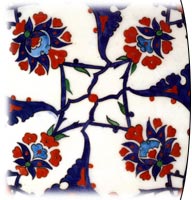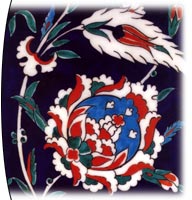İznik Tiles Today
İznik tiles reached their heyday in the 16th century, and the masterpieces produced at that time are regarded as the most valuable specimens of the art of ceramics by the leading museums of the world.
İznik Kiln excavations, carried out for more than 20 years by the Istanbul University Department of Archaeology and History of Art, give us clues as to the types of kilns and ceramics used in the Art of İznik tile making. In the İznik Tiles Atelier opened in mid 1996, following the opening of the İznik Foundatin in 1993 and the Tile and Ceramic Research Centre in 1995, it is now possible to produce tile nearly equalling the quality of those of the 16th century.
Obviously, to reach this point, many experiments were made and everything about İznik tiles was investigated, since the old masters took the secrets to their graves, with the result that even the slightest clue to their manufacture lay concealed for centuries.
 The composition of the tiles and the percentage of the components within the microstructure of the material are carefully studied. The availability of these materials and reserves within the region are considered.
The composition of the tiles and the percentage of the components within the microstructure of the material are carefully studied. The availability of these materials and reserves within the region are considered.
Following the excavations, it is observed that İznik tile production was fire high on wastage owing to the large proportion of quartz in the ceramic. Similarly, a number of experiments with the minerals in the area were carried on in the course of which thousands of experimental plates were produced only to be broken and thrown away. The most unfortunate setback the Foundation has had to face has been the absolute lack of documentation regarding the process. Not even the names of the towns and villages where the materials originated were known.
Thus, the conclusion was arrived at that only through the most meticulous scientific research could unified İznik tile concept be formed.
 In its efforts, the İznik Foundation has received the support of scientific foundations and NGO' s such as TÜBİTAK, M.A.M. (Marmara Research Center), İ.T.Ü. (Istanbul Technical University), İ.Ü. (Istanbul University), in Türkiye, and Princeton and M.I.T. (Massachusetts Institute of Technology) in the United States in a vast range of analysis.
In its efforts, the İznik Foundation has received the support of scientific foundations and NGO' s such as TÜBİTAK, M.A.M. (Marmara Research Center), İ.T.Ü. (Istanbul Technical University), İ.Ü. (Istanbul University), in Türkiye, and Princeton and M.I.T. (Massachusetts Institute of Technology) in the United States in a vast range of analysis.
The production of handmade tiles of the desired quality in this era of speed and automation is a particularly difficult task.
Today, İznik tiles are used as an architectural element in old and modern buildings by the discriminating decorator and art-lover alike.